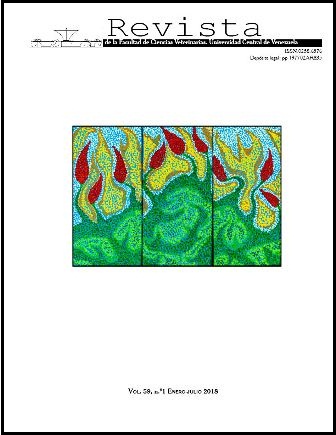RASGOS DE CONDUCTA Y PERFIL HORMONAL DURANTE LOS PRIMEROS 42 D DE GESTACIÓN EN OVEJAS A PASTOREO CON DISPONIBILIDAD DE SOMBRA
Contenido principal del artículo
Resumen
Para caracterizar la frecuencia de observación de algunos rasgos de conducta y evaluar el efecto de la disponibilidad de sombra sobre el perfil de progesterona (P4) y cortisol sérico (ELISA) durante los primeros 42 d de gestación. Un total de 20 ovejas West African fueron distribuidas en dos tratamientos: a) Con sombra (CS): pastoreo en las horas diurnas con disponibilidad de sombra artificial (n=10); b) Sin sombra (SS): pastoreo en las horas diurnas sin disponibilidad de sombra (n=10). Los rasgos de conducta (observación visual) de las ovejas fueron analizados mediante análisis gráficos multivariados (InfoStat/E, versión 2008). Los perfiles de P4 y cortisol fueron analizados con modelos mixtos (PROC MIXED). Las ovejas pastorean principalmente en la mañana, tanto en el tratamiento SS (83,3%) como en el tratamiento CS (81,8%) fuera del toldo (FT). Sin embargo, en la tarde (PM) se observaron ovejas pastoreando bajo el toldo (BT; 15% CSBTPM). La rumia y el consumo de agua no fueron actividades frecuentemente observadas. Los animales del tratamiento CS usaron el toldo para rumiar. Un gran número de ovejas se observaron paradas, sobre todo en el tratamiento SS, tanto AM (80,3%) como PM (98,5%). En concordancia, la frecuencia de ovejas observadas echadas fue baja (9,1% para SSAM y 10,0% para CSBTAM). Las ovejas del grupo SS durante CSBTPM presentaron una frecuencia de 52,5% y 27,3% de hiperventilación, respectivamente, reflejando mejor bienestar térmico en el tratamiento con disponibilidad de sombra. El acceso a sombra, a libre voluntad, durante las horas de pastoreo, no afectó el perfil hormonal de P4 y cortisol durante los primeros 42 d de gestación. Lo anterior sugiere un mecanismo adaptativo de la raza West African que le permite tolerar el estrés calórico sin afectar notablemente su reproducción.
Palabras clave: cortisol; progesterona; ovejas; conducta; pastoreo; sombra
Abstract
Some behavioral traits were characterized and the effect of shade availability on progesterone profile (P4) and serum cortisol (ELISA) at the onset of gestation (first 45 d) in West African sheep was evaluated. A total of 20 sheep were used and allotted in the follows two treatments: a) sheep which grazed during the daytime hours and were provided with artificial shade (AS; n=10); b): sheep which grazed during the daytime hours and were not provided with shade(NAS; n=10). The behavioral traits (visual observation) of sheep were analyzed through a multivariate graphic analysis (Info Stat/E, 2008 version) and the P4 and cortisol profiles, using mixed models (PROCMIXED). The results of the present investigation showed that the majority of sheep grazed during the morning hours, with a proportion of 83.3% corresponding to sheep of treatment NAS, while 81.8% of sheep of AS, grazed outside the awning. However, during the afternoon, 15% of sheep from AS grazed inside the awning. Rumination and water consumption were not frequently observed. Animals of AS had access to the awning to ruminate. A large number (80.3%) of sheep (mainly from NAS) were observed in the standing position during the morning, as well as in the afternoon (98.5%). Similarly, the proportion of laid sheep observed was 9.1% for NAS and 10% for AS, with a frequency of hyperventilation of 52.5% and 27.3%, respectively, reflecting a better thermal comfort in the group with available shade. Free availability to shade during the grazing hours, did not affect the hormonal profile during the first 42 hours of gestation. This suggests an adaptive mechanism of the West African breed that allows it to tolerate heat stress, without notably affecting their reproductive status.
Key words: cortisol; progesterone; ewes; grazing; shade

